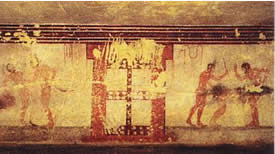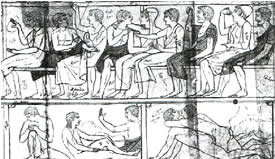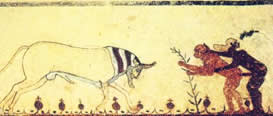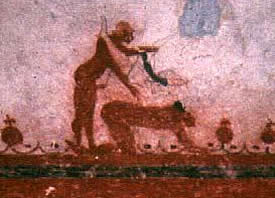|
In harmony with the
Etruscan quest for the uninhibited enjoyment of living came
a desire for scandalous pleasure. We know from Greek historian
Theopompus of Chios that it was common for Etruscan women
to engage in sexual activities with numerous partners even
in the presence of their husbands. There was no embarrassment
in being naked, and sexual acts frequently occurred in public
for all to see. The Tomb of the Floggings has erotic
scenes depicting a woman with two men. It was common to partner
swap and for women to engage in gymnastic sexual positions.
Etruscan men were keen and skillful lovers to their women,
although Theopompus reported that the men preferred boys and
youths. A scene from the Tomb of the Bigas illustrates
an audience for a chariot race of very cozy men with a homosexual
couple making love in plain view. A scene from the Tomb
of Bulls also depicts a homosexual couple on the opposite
side of two heterosexual couples. (MysteriousEtruscans.com;
Hamblin, 60-61)
In addition to the erotic
frescoes, items of pottery from the sixth and fifth Century
also show such erotic scenes. These may, however be copies
or modeled after Greek art of the same period, as it was quite
common for Etruscan artists to emulate their contemporaries.
The blatant usage of erotic scenes on pottery, in tombs and
in combination with Theopompus’s account of Etruscan
society tends to reinforce the belief they were more permissive
than other contemporary societies. Plato even referred to
the Etruscans as immoral and that the word “Etruscan”
itself became almost synonymous with prostitute. Roman historian
Livy describes the rape of Lucretia in his book History
of Rome:
Holding the woman down with his left hand on her breast, he said,
"Be still, Lucretia! I am Sextus Tarquinius. My sword is in
my hand. Utter a sound, and you die!" In fear the woman started
out of her sleep. No help was in sight, but only imminent death.
… When he found her obdurate and not to be moved even by fear
of death, he went farther and threatened her with disgrace, saying
that when she was dead he would kill his slave and lay him naked
by her side, that she might be said to have been put to death in
adultery with a man of base condition. At this dreadful prospect
her resolute modesty was overcome, as if with force, by his victorious
lust; and Tarquinius departed, exulting in his conquest of a woman's
honour.
Despite attempts by her father and husband to console her, Lucretia
could not bear the thought of her honor being forsaken and killed
herself with a knife she concealed in her dress. This story, from
the Roman point of view, certainly does not depict the normal Etruscan
but may have intended to be an example to the repercussions of societal
acceptance of immoral behavior. (MysteriousEtruscans.com; fordham.edu;
Hamblin, 60-61)
| 
Tomb of the Floggings Fresco

Tomb of the Bigas Fresco

Tomb of Bulls Fresco - Homosexual Detail

Tomb of Bulls Fresco - Heterosexual Detail
|







